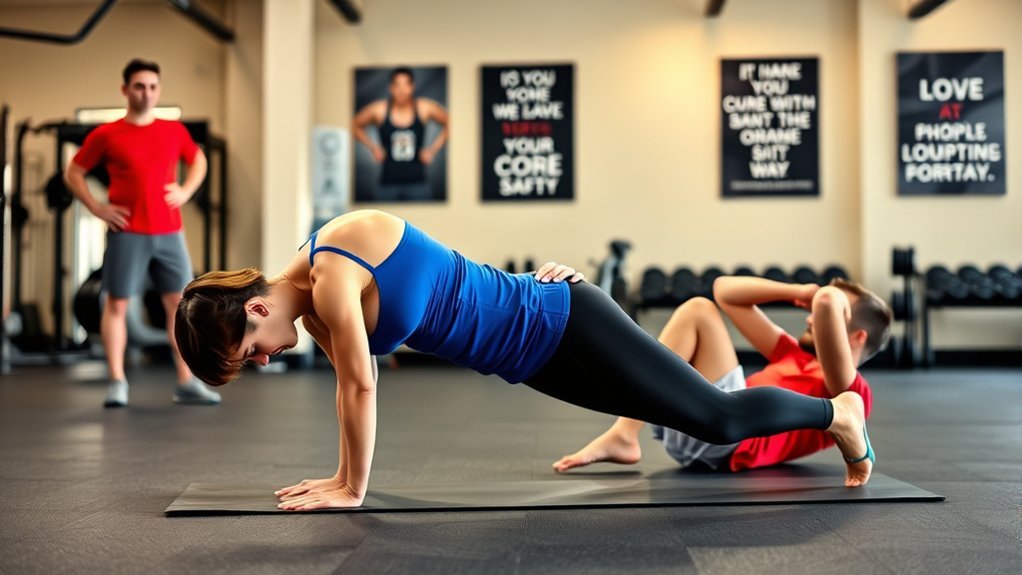When it comes to core-safe moves, knowing the do’s and don’ts can make all the difference in your workout. Engaging your core properly is essential, but it’s just as important to avoid common pitfalls that could lead to injury. As you explore effective exercises and fundamental tips, you’ll discover how to enhance your core training safely. Let’s uncover what you need to prioritize for ideal results.
Understanding Core Engagement
When you engage your core, you’re not just tightening your abdominal muscles; you’re activating a complex network of muscles that support your spine and stabilize your body.
This engagement involves not only your abs but also your obliques, lower back, and pelvic floor. By understanding how to properly engage your core, you can enhance your posture, improve your balance, and prevent injuries during physical activities.
It’s essential to build awareness of these muscles and how they interact, which means practicing engaging them throughout your day. Whether you’re lifting objects or simply standing, a strong core provides a solid foundation.
Do’s of Core-Safe Movements
Engaging your core effectively sets the stage for safe and efficient movements.
To maximize your core engagement during workouts, keep these do’s in mind:
- Focus on Breathing: Inhale deeply to expand your diaphragm and exhale as you tighten your core, creating stability.
- Maintain Proper Posture: Stand tall with shoulders back and down, ensuring your spine stays aligned throughout your movements.
- Use Controlled Movements: Execute exercises slowly and deliberately; this enhances stability and reduces the risk of injury.
- Incorporate Core Exercises: Regularly include planks, bridges, and rotational movements in your routine to strengthen your core effectively.
Don’ts to Avoid When Training Your Core
Although it’s important to focus on core engagement, there are common pitfalls that can undermine your efforts and lead to injury.
First, don’t neglect your form; improper posture can strain your back and diminish the effectiveness of your workout.
Avoid overloading your routine with excessive weights or high repetitions, which can lead to fatigue and increase your risk of injury.
Also, steer clear of movements that cause discomfort or pain; listen to your body.
Finally, don’t skip warm-ups or cool-downs, as they prepare your muscles and help prevent soreness.
Effective Core-Safe Exercises
To build a strong core safely, incorporating effective exercises is essential. Here are four core-safe exercises to evaluate:
Building a strong core safely requires effective exercises that prioritize your well-being.
- Plank: Keep your body in a straight line from head to heels. Engage your core and hold for 30 seconds or longer.
- Bird-Dog: From a tabletop position, extend one arm and the opposite leg. This exercise enhances balance and strengthens your core.
- Dead Bug: Lie on your back, arms up, and legs bent at 90 degrees. Lower one arm and the opposite leg while keeping your back flat.
- Glute Bridge: Lie on your back with knees bent. Lift your hips towards the ceiling, squeezing your glutes, and hold briefly before lowering.
Try these moves to enhance your core strength while prioritizing safety!
Tips for Maintaining Core Safety During Workouts
When you’re working out, maintaining core safety is essential to prevent injury and maximize effectiveness. Start by engaging your core before each move; this helps stabilize your spine and pelvis.
Focus on your form—keep your back straight and avoid excessive arching or rounding. Use controlled movements, avoiding jerky motions that can strain your muscles. If you’re lifting weights, make sure they’re appropriate for your strength level; don’t sacrifice form for heavier weights.
Incorporate rest days to allow your core muscles to recover, and listen to your body—if something feels off, stop immediately.
Finally, stay hydrated and maintain good nutrition to support muscle function and overall strength. Prioritizing these tips will help you achieve a strong, safe core.
Frequently Asked Questions
Can Beginners Perform Core-Safe Exercises Without Prior Experience?
Yes, you can perform core-safe exercises as a beginner. Start with simple movements, focus on form, and listen to your body. Gradually increase intensity as you build strength and confidence in your abilities.
How Often Should I Incorporate Core-Safe Moves in My Routine?
You should incorporate core-safe moves into your routine at least three times a week. Studies show that regular core engagement increases stability by 30%, enhancing your overall strength and reducing injury risk during other activities.
Are There Any Specific Injuries That Core-Safe Exercises Help Prevent?
Yes, core-safe exercises can help prevent injuries like lower back pain, muscle strains, and postural issues. By strengthening your core, you enhance stability and support for your spine, reducing the risk of these common injuries.
Can I Use Weights While Practicing Core-Safe Movements?
Yes, you can use weights while practicing core-safe movements, but start light. Focus on maintaining proper form and control to avoid strain. Gradually increase weight as your core strength improves for effective and safe workouts.
How Do I Know if I’m Engaging My Core Properly?
You’ll know you’re engaging your core properly when it feels like a tight, protective shield around your abdomen. Focus on drawing your belly button toward your spine while maintaining steady breathing during movements. Keep practicing!
Conclusion
By prioritizing core-safe movements, you’re not just protecting your body; you’re also releasing your potential. Imagine feeling stronger and more stable in every aspect of your life, from daily activities to challenging workouts. When you focus on proper technique and listen to your body, you create a powerful connection between mind and muscle. So, embrace these do’s and don’ts, and transform your core training into a journey of strength, safety, and confidence. You’ve got this!
